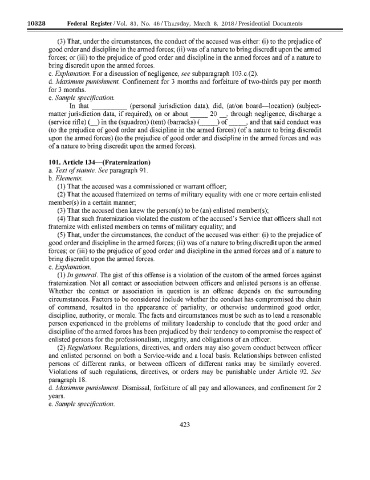Page 625 - Trump Executive Orders 2017-2021
P. 625
10328 Federal Register / Vol. 83, No. 46 / Thursday, March 8, 2018 / Presidential Documents
(3) That, under the circumstances, the conduct of the accused was either: (i) to the prejudice of
good order and discipline in the armed forces; (ii) was of a nature to bring discredit upon the armed
forces; or (iii) to the prejudice of good order and discipline in the armed forces and of a nature to
bring discredit upon the armed forces.
c. Explanation. For a discussion of negligence, see subparagraph 103.c.(2).
d. Maximum punishment. Confinement for 3 months and forfeiture of two-thirds pay per month
for 3 months.
e. Sample specification.
In that (personal jurisdiction data), did, (at/on board-location) (subject-
matter jurisdiction data, if required), on or about __ 20 _, through negligence, discharge a
(service rifle)(_) in the (squadron) (tent) (barracks)( __ ) of __ , and that said conduct was
(to the prejudice of good order and discipline in the armed forces) (of a nature to bring discredit
upon the armed forces) (to the prejudice of good order and discipline in the armed forces and was
of a nature to bring discredit upon the armed forces).
101. Article 134-(Fraternization)
a. Text (?{statute. See paragraph 91.
b. F:lements.
(1) That the accused was a commissioned or warrant officer;
(2) That the accused fraternized on terms of military equality with one or more certain enlisted
member(s) in a certain manner;
(3) That the accused then knew the person(s) to be (an) enlisted member(s);
(4) That such fraternization violated the custom of the accused's Service that otiicers shall not
fraternize with enlisted members on terms of military equality; and
(5) That, under the circumstances, the conduct of the accused was either: (i) to the prejudice of
good order and discipline in the armed forces; (ii) was of a nature to bring discredit upon the armed
forces; or (iii) to the prejudice of good order and discipline in the armed forces and of a nature to
bring discredit upon the armed forces.
c. t-xplanation.
(1) in general. The gist of this offense is a violation of the custom of the armed forces against
fraternization. Not all contact or association between officers and enlisted persons is an offense.
Whether the contact or association in question is an offense depends on the surrounding
circumstances. Factors to be considered include whether the conduct has compromised the chain
of command, resulted in the appearance of partiality, or otherwise undennined good order,
discipline, authority, or morale. The facts and circumstances must be such as to lead a reasonable
person experienced in the problems of military leadership to conclude that the good order and
discipline of the armed forces has been prejudiced by their tendency to compromise the respect of
enlisted persons for the professionalism, integrity, and obligations of an officer.
(2) Regulations. Regulations, directives, and orders may also govern conduct between officer
and enlisted personnel on both a Service-wide and a local basis. Relationships between enlisted
persons of different ranks, or between officers of different ranks may be similarly covered.
Violations of such regulations, directives, or orders may be punishable under Article 92. See
paragraph 18.
d. Maximum punishment. Dismissal, forfeiture of all pay and allowances, and confinement for 2
years.
sradovich on DSK3GMQ082PROD with PRES DOCS VerDate Sep<11>2014 18:39 Mar 07, 2018 Jkt 244001 PO 00000 Frm 00442 Fmt 4705 Sfmt 4790 E:\FR\FM\08MRE0.SGM 08MRE0 ER08MR18.444</GPH>
e. Sample spec?fication.
423

